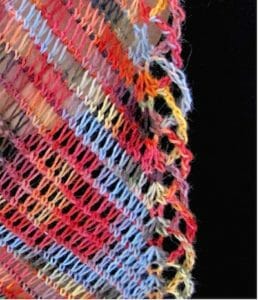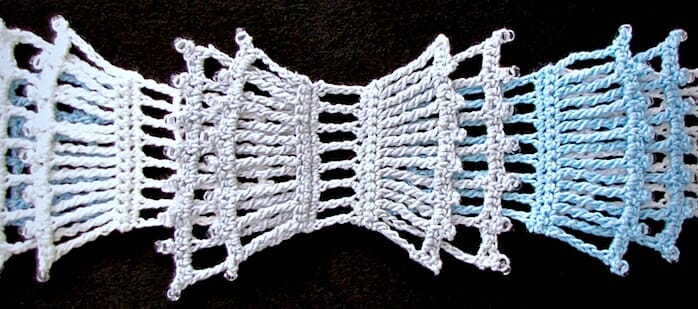Pictured above: Cantina in beaded Lotus. Also see triple trebles in the Dessert Party Apron.
When tall stitches look very different from each other, or lumpy, stringy, loose, or too short, we just need to take more control of them. Especially vexing is when the top loops look loose and loopy! My solutions below will help you crochet even the very tall stitches that look downright handsome. First, some basics of crochet.
Tall & Taller Crochet Stitches
A basic rule of crochet is if you already know how to do the double crochet stitch (US: dc, UK/AUS: tr), it’s easy to understand how to make the taller ones. Here’s how to crochet the dc into a row of stitches:
Yarn over and insert your crochet hook under the top two loops of the next stitch of the row. Yarn over and pull up a loop; you now have three loops on your hook. *Yarn over and pull the loop through two of the loops on your hook, then repeat from the * once: only one loop remains on your hook.
An amazing feature of crochet is there’s no limit to a stitch’s height. Start with the double crochet stitch as the model for crocheting any taller stitch. Here’s how to make a treble, the next taller stitch:
Yarn over two times (instead of once for a dc). Insert your crochet hook under the top two loops of the next stitch of the row like you would for a dc, yarn over and pull up a loop; you now have four loops on your hook. *Yarn over and pull the loop through two of the loops on your hook, repeat from the * until only one loop remains on your hook—for a treble, that’s twice more.
With each taller stitch (double trebles and so on) you yarn over more times and then work the loops off of the hook in pairs, just like you do to make a dc and tr. The only difference is that you have more pairs of loops to work off.
What About Tall Stitch Variations?

Note that I’m sticking closely to the basic stitches here. That means I’m leaving out:
- other types of tall stitches, such as the extended ones of half-step heights,
- other ways to add loops to the hook, and
- more ways to crochet them into other stitches.
- Also, tall Tunisian stitches.
These non-basic stitches have the same problems with loose top loops. My tips below will help.
A Better Start
Our goal is no slack in our loops beyond what’s needed for crocheting at our normal smooth and easy gauge. This is not about crocheting tighter. It’s about identifying where we let extra yarn creep in.
Buff your crochet hook surface.
Even slight, imperceptible residue will cause you to need a bit more slack in your loops. For a few seconds I vigorously rub the whole stitch-making zone of the hook with a soft cloth (preferably microfiber or chamois). I do this when I start a new project, resume crocheting one after a long break, or daily during peak summer humidity.
Adjust the initial loops.
The loop that’s already on your hook will become the top two loops of the new stitch. I tug on it gently to tighten. The loop should still slide freely along the main part of the hook (not the narrower tapered neck of it).
Let’s start a triple treble (US: trtr, UK/AUS: quadtr). I yarn over four times and immediately slide all the loops together while tugging a bit on my yarn. This removes unnecessary slack. They should still slide well on the hook as a neat, snug group. Keep your thumb or forefinger on the group so that they don’t loosen as you start crocheting.
It’s easy to overlook how much extra yarn we add to a stitch if the yarn overs spread out along the hook. (Keep this in mind for lacy Tunisian crochet too!) This will become a quick automatic movement after a while.
Better Stitch Making
While working the loops off of my hook in pairs, I pull up a bit on the loops. This has two benefits.
Lifting adds elegance.
If you think of the base of a stitch as having two “feet” planted in a stitch, then pulling up a bit higher while working the stitch creates longer “ankles” and a streamlined body. I first learned this about the dc from Pauline Turner in her Crocheted Lace book (Martingale, 2003). She explains why even experienced crocheters can have trouble getting a doily to lie flat if their stitch heights vary from the designer’s.
Lifting while making your tall stitches will help you get row gauge for filet lace projects. Feel free to add a chain to your turning chains if lifting makes your row a whole chain taller.
Use the “reserve” yarn.
Not all of the yarn is coming from the ball of yarn to complete the stitch. Some comes from the “reserve” yarn that’s wrapped around the hook. As I crochet I’m almost miserly about the yarn coming from the ball as I pull up a bit, yarn over, and pull through two loops at a time.
Try it: go slowly and watch how more yarn gets pulled off of your hook if you restrict the flow of yarn from the ball.
Part of this motion is that I’m also tilting my hook at a sharp angle. The head is pointing almost straight down as I pull a loop through the next two loops on the hook. This helps the yarn slip from hook and into the stitch at a pretty angle.
The stitches comes out uniformly neat and orderly looking. These subtle crocheting adjustments will become automatic and feel natural.
The Yarn Matters
Crocheting a tall stitch involves a lot of wrapping. A right-handed crocheter wraps the yarn around the hook in a counter-clockwise direction. It either untwists a yarn, or adds more twist, depending on whether the yarn starts out with a clockwise or counterclockwise twist (a.k.a. “S-twist” or “Z-twist”).
This is really noticeable sometimes. The tall stitches look stringy or uneven for several reasons:
- It’s hard to work the loops off the hook evenly without splitting the plies of yarn.
- A yarn flattens when it loses twist. This affects how the stitch looks.
- Separated yarn plies add a stringy look to the surface of a completed stitch.
The fiber blend matters. Slippery yarns add challenge, and so do yarns with uneven bumps. Sometimes trying different crochet hooks helps (remember to buff them first).
When you’ve tried everything, it’s not you. Occasionally, tall stitches are going look looser no matter what you do! Blocking might help.
Tall stitches love a good blocking.

This probably sounds about as fresh and exciting as “take time to check your gauge” but the transformation is so worth it.
Tall crochet stitches are structurally complex. Blocking gives the yarn strands a chance to absorb the energy you added with all the wrapping and looping, and to meld evenly into a stable column.
Your tall stitches will respond even more handsomely to blocking if your yarn does. Natural fiber content helps because it responds so readily, but you can also block some 100% acrylic yarns with steam very carefully.
Crochet’s lacy beauty really shines through with the tall stitches, doesn’t it? I fall in love with crochet all over again when I use them.

